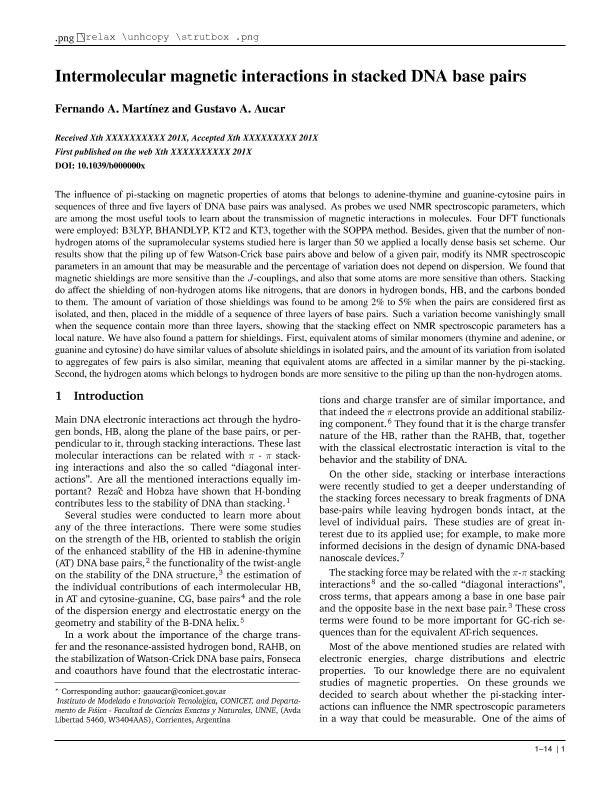Mostrar el registro sencillo del ítem
dc.contributor.author
Martínez, Fernando Ariel

dc.contributor.author
Aucar, Gustavo Adolfo

dc.date.available
2018-04-27T18:48:45Z
dc.date.issued
2017-10
dc.identifier.citation
Martínez, Fernando Ariel; Aucar, Gustavo Adolfo; Intermolecular magnetic interactions in stacked DNA base pairs; Royal Society of Chemistry; Physical Chemistry Chemical Physics; 19; 40; 10-2017; 27817-27827
dc.identifier.issn
1463-9076
dc.identifier.uri
http://hdl.handle.net/11336/43689
dc.description.abstract
The influence of pi-stacking on the magnetic properties of atoms that belong to adenine-thymine and guanine-cytosine pairs in sequences of three and five layers of DNA base pairs was analysed. As probes we used NMR spectroscopic parameters, which are among the most useful tools to learn about the transmission of magnetic interactions in molecules. Four DFT functionals were employed: B3LYP, BHANDLYP, KT2 and KT3, together with the SOPPA method. Besides, given that the number of non-hydrogen atoms of the supramolecular systems studied here is larger than 50 we applied a locally dense basis set scheme. Our results show that the piling up of a few Watson-Crick base pairs above and below a given pair modifies its NMR spectroscopic parameters by an amount that may be measurable and the percentage of variation does not depend on dispersion. We found that magnetic shieldings are more sensitive than J-couplings, and also that some atoms are more sensitive than others. Stacking affects the shielding of non-hydrogen atoms like nitrogens, that are donors in hydrogen bonds, HBs, and the carbons bonded to them. The amount of variation of these shieldings was found to be from 2% to 5% when the pairs are considered first as isolated, and then, placed in the middle of a sequence of three layers of base pairs. Such a variation becomes vanishingly small when the sequence contains more than three layers, showing that the stacking effect on NMR spectroscopic parameters has a local nature. We have also found a pattern for shieldings. First, equivalent atoms of similar monomers (thymine and adenine, or guanine and cytosine) have similar values of absolute shieldings in isolated pairs, and the amount of variation from isolated pairs to aggregates of a few pairs is also similar, meaning that equivalent atoms are affected in a similar manner by pi-stacking. Second, the hydrogen atoms which belong to hydrogen bonds are more sensitive to the piling up than the non-hydrogen atoms.
dc.format
application/pdf
dc.language.iso
eng
dc.publisher
Royal Society of Chemistry

dc.rights
info:eu-repo/semantics/openAccess
dc.rights.uri
https://creativecommons.org/licenses/by-nc-sa/2.5/ar/
dc.subject
Nmr
dc.subject
Magnetic Shieldings
dc.subject
Hydrogen Bonds
dc.subject.classification
Física Atómica, Molecular y Química

dc.subject.classification
Ciencias Físicas

dc.subject.classification
CIENCIAS NATURALES Y EXACTAS

dc.title
Intermolecular magnetic interactions in stacked DNA base pairs
dc.type
info:eu-repo/semantics/article
dc.type
info:ar-repo/semantics/artículo
dc.type
info:eu-repo/semantics/publishedVersion
dc.date.updated
2018-04-26T17:55:07Z
dc.identifier.eissn
1463-9084
dc.journal.volume
19
dc.journal.number
40
dc.journal.pagination
27817-27827
dc.journal.pais
Reino Unido

dc.description.fil
Fil: Martínez, Fernando Ariel. Consejo Nacional de Investigaciones Científicas y Técnicas. Centro Científico Tecnológico Conicet - Nordeste. Instituto de Modelado e Innovación Tecnológica. Universidad Nacional del Nordeste. Facultad de Ciencias Exactas Naturales y Agrimensura. Instituto de Modelado e Innovación Tecnológica; Argentina
dc.description.fil
Fil: Aucar, Gustavo Adolfo. Consejo Nacional de Investigaciones Científicas y Técnicas. Centro Científico Tecnológico Conicet - Nordeste. Instituto de Modelado e Innovación Tecnológica. Universidad Nacional del Nordeste. Facultad de Ciencias Exactas Naturales y Agrimensura. Instituto de Modelado e Innovación Tecnológica; Argentina
dc.journal.title
Physical Chemistry Chemical Physics

dc.relation.alternativeid
info:eu-repo/semantics/altIdentifier/doi/http://dx.doi.org/10.1039/c7cp04484d
dc.relation.alternativeid
info:eu-repo/semantics/altIdentifier/url/http://pubs.rsc.org/en/Content/ArticleLanding/2017/CP/C7CP04484D
Archivos asociados
